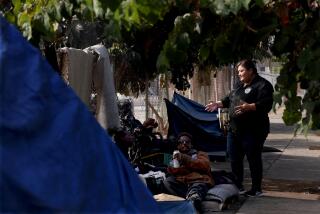March madness
- Share via
BARELY TWO WEEKS after the May 1 melee at MacArthur Park, immigrant rights activists are already planning another demonstration, this one in Hollywood in late June. They should quit while they’re ahead. Mass street demonstrations are a high-risk political strategy that quickly reaches the point of diminishing returns. Organizers should ask themselves whether they’re really trying to appeal to the goodwill of the general public -- and Congress, as it debates immigration reform -- or simply grandstanding.
There is little doubt that last year’s mega-marches were both impressive and politically effective. The presence of large numbers of real people -- as opposed to what I would call professional protesters -- was refreshing and awe-inspiring. Those jubilant marches helped turn the political tide and derailed the most punitive elements of last year’s immigration legislation. Although some Americans were horrified by the sight -- particularly by the presence of Mexican flags -- more than a few elected officials were prompted to take the message seriously.
But let’s be honest, this year’s May Day demonstrations in Los Angeles -- which brought out about 35,000 marchers compared to last year’s 650,000 -- were a dud in terms of political punch -- until the LAPD gave them new meaning. Consequently, they barely registered in the nation’s capital, at least on the issues that mattered to the marchers.
“So what? They’re doing it again, but even less so,” I was told by one Washington insider involved in congressional negotiations over immigration. “Particularly right now, when we’re trying to get the Republicans to do the right thing, these marches don’t help. But nor do they really hurt. They just don’t matter.”
Call me cynical, but given the disappointing turnout, I suspect that some immigrant rights activists might even be thankful for the awful performance of the Los Angeles Police Department.
“The LAPD’s overreaction was great for the movement,” said Fernando Guerra of Loyola Marymount University’s Center for the Study of Los Angeles. “It changed the headlines from ‘Low Turnout’ to ‘Police Abuse’ and re-energized organizers.”
Though he still believes that marches can be effective, Guerra acknowledges that street protests don’t always work. “You can’t ignore a half-million people in the street,” he said. “But you can possibly ignore less than 50,000. It’s difficult to mobilize masses of people; it’s extraordinarily difficult to sustain mass mobilization.”
Although some organizers might think that they can leverage public outrage over police abuse to push more people into the streets, do they really think the next march or the one after that is going to top or even match the numbers and effect of last year’s turnout? If not, why are they so quick to resort to demonstrations?
“I think there are three reasons,” said Marshall Croddy, director of programs for the Constitutional Rights Foundation, a nonpartisan organization that helps educate students on the importance of civic participation. “First, it’s an iconic way of getting a message across. It has the sanctity of the civil rights movement. Second, it gives organizers a sense that something is happening. And third, it’s relatively easy compared to the difficult political work that has to be done.”
This year and last, the Los Angeles Unified School District asked Croddy and his organization to develop a curriculum to help students learn about and discuss the issues involved in the protests. Among other lessons, the foundation’s study guide describes the variety of options people have to affect public policy. While demonstrations have their strengths, it tells students, they run the risk of becoming violent, which can sway public opinion against the marchers and their cause.
Remember, on May 1, the police overreacted to violence that was initiated by protesters. Yes, they were part of an anarchist fringe, as the media has carefully pointed out, but they were marchers nonetheless.
Therein lies the main reason the immigrant rights organizers should leave well enough alone. They can’t control who comes to their protests, let alone manage their behavior. Nor can they control how the media will frame whatever story emerges. Police behavior dominated the headlines this time. But what if the anarchists’ bottle-throwing had sparked crowd violence and had been the focus of all those video cameras. And what if the police had showed restraint? Would that have been good for the cause of immigrant rights? Hardly.
Mayor Antonio Villaraigosa is right to assure immigrants that they have a right to protest peacefully. But surely he too is uneasy with the potential for mass demonstrations to go awry. Why else would a vocal supporter of immigrants’ rights have flown to El Salvador on the day of the protests? Like disc jockey Eddie “Piolin” Sotelo, who helped put so many people in the streets last year but is now advocating a massive letter-writing campaign, perhaps His Honor should encourage citizens and noncitizens to push for change in other ways.
Not only are the risks of marching too high, but the potential political rewards are too low. The goal is humane immigration legislation. Let’s hope that activists don’t just protest for protesting’s sake.
More to Read
Sign up for Essential California
The most important California stories and recommendations in your inbox every morning.
You may occasionally receive promotional content from the Los Angeles Times.










